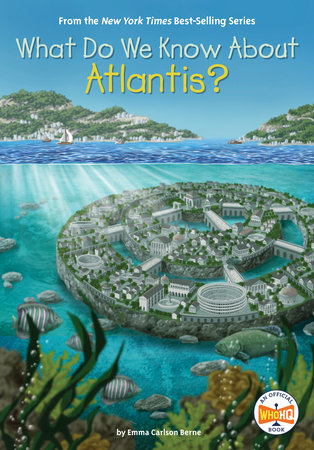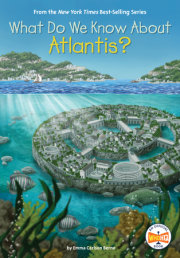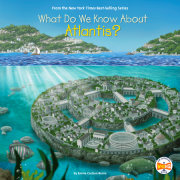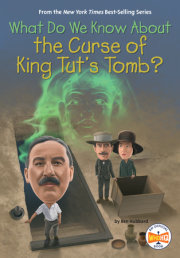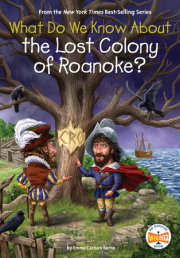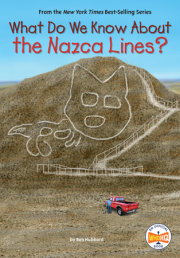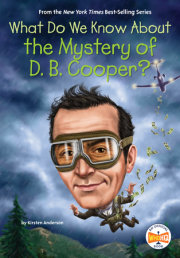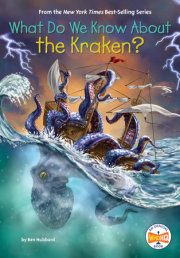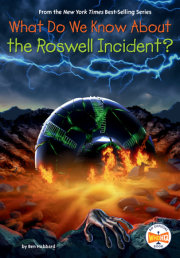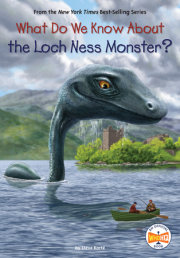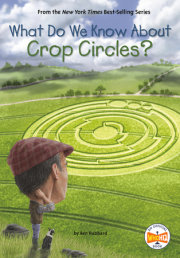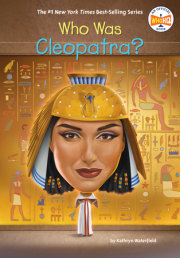What Do We Know About Atlantis?The hot sun blazed down on Spyridon’s head. He pulled his pith helmet farther down his brow and ignored the sweat trickling down his neck. He sat back on his heels and gazed into the excavated pit in front of him. Spyridon Marinatos had been an archeologist for forty years. By 1967, he was a professor. He was the inspector general of the Greek Antiquities Service. He’d excavated too many artifacts in his career to count. But this—
this—was the most exciting dig he’d ever led.
They’d only been digging for a few weeks on the Greek Island of Santorini, but already, they’d found a stone doorway, the base of a column, and piles of old pottery. People had lived here—lots of people. Now, the forty miners helping the team were carefully scraping away the hard, chalky dirt. Most of the nearby villagers were busy harvesting their tomato crop, but a few wandered away from their fields to watch. Then, a shout went up. One of the diggers had found flakes of plaster—white. Spyridon ran over to him. Frescoes! The plaster was from painted murals that had once decorated the walls of ancient buildings and homes.
The excitement spread. The team kept digging. The artifacts were everywhere, all around them—more painted frescoes: black, pink, green, red. Walls reinforced by wooden poles, huge limestone blocks that must have supported giant buildings, cooking pots, wine jugs, looms for weaving, paved streets, plumbing systems! This ancient civilization had
running water!
The weeks went by and the dig went on. More and more treasures were unearthed. There were huge murals of flowers, women, and bulls. One showed three ladies in a field full of crocus blossoms. Another showed a group of monkeys climbing rocks beside a river. The team found three-story buildings with elaborate staircases. They found paved roads and huge storage rooms filled with containers of wine and oil. There were artifacts from other places in the world. These ancient people traveled, which meant they must have had ships. Somewhere under there, Spyridon suspected, there could be a palace.
An ancient city, full of beautiful art and graceful buildings. A wealthy city with many ships. A city and its people buried forever in a sudden explosion of molten lava and ash. An island vanished overnight.
Could this be
it? The lost city of Atlantis?
No, Spyridon insisted. He was a professional scientist and a respected professor, not a storyteller. He was certain the story of Atlantis was a myth. It was only a legend, wasn’t it?
Chapter 1: The Lost City
The story of Atlantis begins in about 360 BCE, during the time of the ancient Greeks. It is the story of a paradise described by a philosopher named Plato. The people in Plato’s beautiful city were wealthy and powerful. But they weren’t just people. They were half-god and half-human (called demigods). This place wasn’t ruled by a president or a king. Instead, its ruler was Poseidon, the Greek god of the seas.
In this gorgeous city, flowers bloomed, tree branches waved in the sun, and fruit and grain of every type grew tall under the blue sky. Elephants wandered the land. People made jewelry and decorations from precious metals more valuable than gold. They had plenty of stone for building and carving.
The demigods controlled a vast fleet of ships. They traveled all over the world and brought back treasures to decorate their huge houses. They had hot and cold running water in their bathhouses. They had separate baths for men and women, and even for horses. They had paved streets and a massive racetrack for their horses.
And the people of this city were wealthy enough to build an elaborate temple to Poseidon at the center of town and decorate it with sheets of silver. They carved a massive sculpture of Poseidon standing in a chariot, with a hundred attendants riding dolphins around him. Walls of gold surrounded the temple, along with golden statues.
These demigods were happy in their paradise. They lived peacefully among the green grass and blue waters. They were wise and calm and not concerned with money or power. They worshipped their gods and the gods protected them.
Plato said that Atlantis was made up of islands lying inside each other in rings. Water separated these rings, and a canal ran right down the middle. This was so ships could sail through. The Atlanteans built their homes using colors of stone: black, white, and red. They decorated all the walls around their islands with brass and tin. Their ships floated in a huge port, and the island had a big, flat plain for growing crops.
The Atlanteans, Plato said, were perfect. Their life was perfect. Until it wasn’t.
As the years went by, the Atlanteans started getting greedy. They started becoming more like people and less like gods. They grew selfish and forgot how to get along. They fought with one another, trying to snatch more and more wealth and power.
The gods were watching, of course, and they did
not like what they were seeing. Zeus, the god of the sky and the ruler of all gods and humans, declared that the Atlanteans needed to be punished. He’d take care of that. In one night, Zeus struck Atlantis down. He sent fire rolling over the city and earthquakes to shake apart the land. Buildings tumbled into the sea. People were swept into the water. And the city of Atlantis, trembling and cracking, sank down, down, under the roiling waves, to the bottom of the sea, never to be seen again.
No one knows if Plato’s story of gods and demigods in Atlantis is true. Plato, after all, was a pretty creative thinker. And he was a great storyteller.
Parts of the Atlantis story are pretty clearly not true: the demigods and the god Zeus punishing the Atlanteans. People think that Plato may have made the story up to teach a lesson about what happens when people get too greedy.
But Plato’s story is strangely detailed. He even includes the location of Atlantis—just west of the Strait of Gibraltar. The Strait of Gibraltar is the narrow strip of ocean that separates Spain and the northern coast of Africa. Plato notes exactly how big Atlantis was, with measurements. Why would he include all these details about a made-up city if he was just trying to teach a lesson?
Could Plato have used the history of a
real city? A city that really
did sink into the ocean, carrying all its treasures and beauty with it? Maybe Plato just exaggerated the story of that real city and added his own details about the gods.
Or maybe not. Explorers, researchers, and ordinary people have devoted their lives to finding out the truth. Where is Atlantis? What
was Atlantis? Why did this city of gold and silver disappear so suddenly? And could we possibly find it again?
Since Plato’s time, people have enjoyed the story of Atlantis so much that they’ve told and retold it. Even after Plato died, other ancient Greeks kept the story alive. Plutarch, another philosopher, reminded his readers of Plato’s story five hundred years later.
Some took the story literally. A man named Crantor had been taught by a student of Plato’s. He thought Atlantis had to be a real place and traveled to Egypt to find proof that it existed. In Egypt, according to legend, Crantor found columns carved with hieroglyphs that spelled out the history of Atlantis.
Zoom forward a thousand or so years: The story of Atlantis had faded for most people. They’d moved on to other legends. But it wasn’t completely forgotten. In 1492, Christopher Columbus sailed from Spain across the Atlantic Ocean. As the
Niña, the
Pinta, and the
Santa Maria neared land, Columbus was sure he had found the East Indies—what we now call India, China, and Japan. He also thought he just might be sailing near the location of Plato’s Atlantis!
During the 1500s and 1600s, important and influential men like Thomas More (a British lawyer who served King Henry VIII) and Francis Bacon (attorney general and lord chancellor of England) wrote about Atlantis, too. They didn’t spend their time sailing around looking for it, but they liked to think about perfect worlds and perfect people working perfectly together.
For Columbus, and other explorers and philosophers, Atlantis had been more of a dream than a reality. They wondered about it and wrote about it. They never seriously considered trying to find it. But a few hundred years later, all of that would change.
Copyright © 2022 by Penguin Random House LLC. All rights reserved. No part of this excerpt may be reproduced or reprinted without permission in writing from the publisher.

